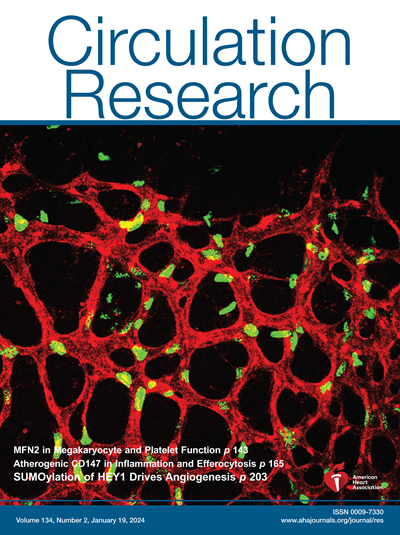Vagal Stimulation Rescues HFpEF by Altering Cardiac Resident Macrophage Function.
IF 16.2
1区 医学
Q1 CARDIAC & CARDIOVASCULAR SYSTEMS
引用次数: 0
Abstract
BACKGROUND We previously showed in a rat model of heart failure with preserved ejection fraction (HFpEF) that transcutaneous vagus nerve stimulation (tVNS) reduced cardiac fibrosis and inflammation. However, macrophage-mediated mechanisms through which tVNS rescues cardiac function remain poorly understood. METHODS We induced HFpEF in 8-week-old mice by a combination of a high-fat diet and l-NG-nitro arginine methyl ester for 5 weeks, followed by 4 weeks of tVNS or sham stimulation. At this time, we analyzed cardiac function by echocardiography and immune cell numbers by single-cell RNA sequencing and flow cytometry. RESULTS Our data demonstrate that HFpEF mice exhibited diastolic dysfunction, left ventricular hypertrophy, and fibrosis, consistent with HFpEF, and that tVNS significantly improved HFpEF severity. Analysis of merged single-cell RNA sequencing data from control, HFpEF+sham, and HFpEF+tVNS mice showed that HFpEF was associated with the accumulation of Spp1-expressing CCR2 (C-C chemokine receptor type 2)+ cardiac resident macrophages (CRM). Furthermore, treatment with tVNS reduced the number of CCR2+ CRM and the expression of Spp1 while also inducing the expression of Igf1 in TLF+ (Timd4+/Lyve1+/Folr2+) and MHC2+ CRM. Global deletion of Spp1 or blockade of CCR2+ CRM recruitment improved HFpEF, whereas TLF+/MHC2+ specific deletion of Igf1 reversed the protective effect of tVNS on HFpEF. The benefits of tVNS were also abolished in the setting of disrupted acetylcholine/α7nAChR (α7 neuronal acetylcholine receptor) signaling, either via pharmacological inhibition of α7nAChR or choline acetyltransferase deletion in CD4+ T cells. CONCLUSIONS Collectively, our data indicate that tVNS improves HFpEF by reducing Spp1 expressing CCR2+ CRM and inducing expression of proreparative Igf1 in TLF+/MHC2+ CRM. These effects are mediated through cholinergic signaling, highlighting a neuroimmune pathway in HFpEF.迷走神经刺激通过改变心脏巨噬细胞功能来拯救HFpEF。
我们之前在一个保留射血分数(HFpEF)的心力衰竭大鼠模型中发现,经皮迷走神经刺激(tVNS)可以减少心脏纤维化和炎症。然而,巨噬细胞介导的tVNS拯救心功能的机制仍然知之甚少。方法采用高脂饮食和l- ng -硝基精氨酸甲酯联合诱导8周龄小鼠HFpEF,持续5周,然后进行4周的tVNS或假刺激。此时,我们通过超声心动图分析心功能,通过单细胞RNA测序和流式细胞术分析免疫细胞数量。结果HFpEF小鼠表现出舒张功能障碍、左心室肥厚和纤维化,与HFpEF一致,tVNS显著改善HFpEF严重程度。对照、HFpEF+sham和HFpEF+tVNS小鼠的合并单细胞RNA测序数据分析显示,HFpEF与表达spp1的CCR2 (C-C趋化因子受体2型)+心脏常驻巨噬细胞(CRM)的积累有关。此外,tVNS治疗减少了CCR2+ CRM的数量和Spp1的表达,同时诱导了TLF+ (Timd4+/Lyve1+/Folr2+)和MHC2+ CRM中Igf1的表达。Spp1的全局缺失或CCR2+ CRM招募的阻断可改善HFpEF,而TLF+/MHC2+特异性缺失Igf1逆转了tVNS对HFpEF的保护作用。在乙酰胆碱/α7nAChR (α7神经元乙酰胆碱受体)信号被破坏的情况下,tVNS的益处也被取消,无论是通过药理抑制α7nAChR还是在CD4+ T细胞中胆碱乙酰转移酶缺失。综上所述,我们的数据表明,tVNS通过降低CCR2+ CRM中Spp1的表达和诱导TLF+/MHC2+ CRM中制备性Igf1的表达来改善HFpEF。这些作用是通过胆碱能信号传导介导的,突出了HFpEF的神经免疫途径。
本文章由计算机程序翻译,如有差异,请以英文原文为准。
求助全文
约1分钟内获得全文
求助全文
来源期刊

Circulation research
医学-外周血管病
CiteScore
29.60
自引率
2.00%
发文量
535
审稿时长
3-6 weeks
期刊介绍:
Circulation Research is a peer-reviewed journal that serves as a forum for the highest quality research in basic cardiovascular biology. The journal publishes studies that utilize state-of-the-art approaches to investigate mechanisms of human disease, as well as translational and clinical research that provide fundamental insights into the basis of disease and the mechanism of therapies.
Circulation Research has a broad audience that includes clinical and academic cardiologists, basic cardiovascular scientists, physiologists, cellular and molecular biologists, and cardiovascular pharmacologists. The journal aims to advance the understanding of cardiovascular biology and disease by disseminating cutting-edge research to these diverse communities.
In terms of indexing, Circulation Research is included in several prominent scientific databases, including BIOSIS, CAB Abstracts, Chemical Abstracts, Current Contents, EMBASE, and MEDLINE. This ensures that the journal's articles are easily discoverable and accessible to researchers in the field.
Overall, Circulation Research is a reputable publication that attracts high-quality research and provides a platform for the dissemination of important findings in basic cardiovascular biology and its translational and clinical applications.
 求助内容:
求助内容: 应助结果提醒方式:
应助结果提醒方式:


